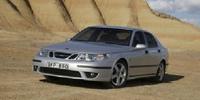Saab 9-5 and Its Drivers Top HLDI Safety Study
DETROIT November 4, 2004; Drivers of the Saab 9-5 sedan and 9-5 SportWagon are among the safest group of drivers in the market. According to the recently published Highway Loss Data Institute (HLDI) report, the Saab 9-5 sedan topped the luxury midsize category for relative frequency of injury insurance claims.
HLDI’s study, covering model years 2001-2003, compares cars on the basis of cost of injuries sustained following on-road crashes. The study indicates the relative frequencies of injury compensation claims from an insurance company, per insured vehicle year.
Both the 9-5 sedan and SportWagon achieved a rating of “substantially better than average” for injury claims in the luxury midsize category. According to the HLDI formula, the Saab 9-5 sedan’s top ranking for injury claims is 53 percent better than average, and the Saab 9-5 SportWagon’s ranking is 39 percent better than average. Saab congratulates its drivers who significantly helped achieve these top scores.
Saab’s real-life safety philosophy puts priority on systems and structures that help protect Saab occupants during a real-world collision. Although Saab conducts numerous laboratory crash tests and other tests on the 9-5 — including simulated animal collisions and truck-to-car side impacts — it is real-life collisions and their infinite variables that drive Saab safety engineers and their work.
One feature that distinguishes the Saab 9-5 from its competitors is the Saab Active Head Restraint (SAHR) system in the front seats. Investigations have shown that this system reduces the risk of whiplash to front-seat occupants in rear-end collisions by as much as 75 percent, compared with older Saab vehicles without active head restraints.
Other standard safety features on the Saab 9-5 sedan and SportWagon include:
• Front and rear crash deformation zones that absorb energy in a controlled way • Head thorax side airbags and dual-stage front airbags • 3-point seatbelts on all seating positions • Front seatbelts with pretensioners and load limiter • Side-impact door beams • Anti-lock braking system (ABS) • Electronic Stability Program (ESP) • Welded steel construction/Safety cage design • Energy-absorbing steering column • Pedal release system
A vehicle's safety performance is the product of many factors, including driver and occupant behavior, personal judgment and other variables. The design of the car also influences its real-life safety integrity. The 2004 HLDI data supports that when it comes to injury insurance claim rates, Saab and Saab drivers perform well together in the real world. For more information, the complete report can be found on the HLDI Internet website at www.carsafety.org.
Insurance company claims for theft losses are also compared in the HLDI report, and once again, the Saab 9-5 sedan is the best in the luxury midsize class. With a “better than average” ranking, the 9-5 sedan suffered 60 percent fewer theft claims than other cars per insured vehicle year. The 9-5 SportWagon includes the same anti-theft protection as the sedan, but was not rated because of insufficient data.



